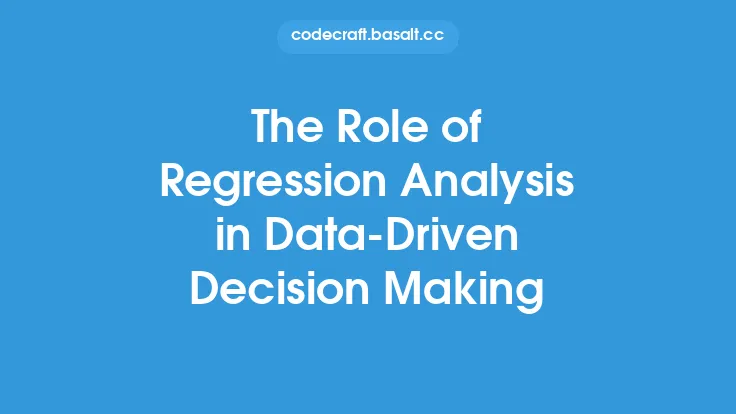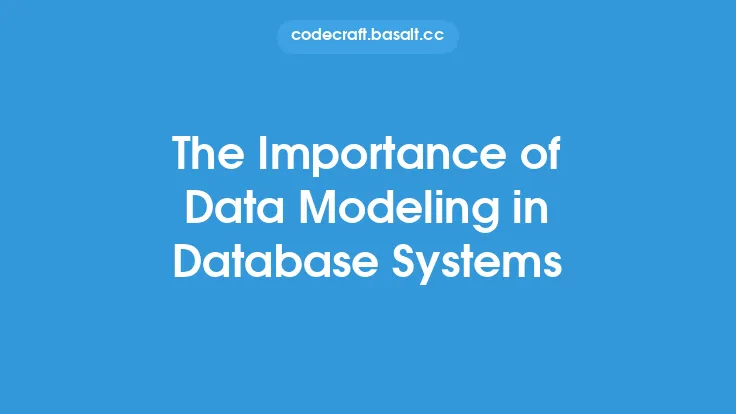Regression analysis is a cornerstone of predictive modeling, allowing data scientists and analysts to establish relationships between variables and make informed predictions about future outcomes. At its core, regression analysis involves the use of statistical models to identify the relationships between a dependent variable (the outcome of interest) and one or more independent variables (the predictors). This technique is essential in machine learning, as it enables the development of predictive models that can be used to drive business decisions, optimize processes, and solve complex problems.
Key Concepts in Regression Analysis
Regression analysis involves several key concepts, including the coefficient of determination (R-squared), which measures the proportion of variance in the dependent variable that is explained by the independent variables. A high R-squared value indicates a strong relationship between the variables, while a low value suggests a weak relationship. Another important concept is the residual, which represents the difference between the observed and predicted values of the dependent variable. Residuals are used to evaluate the fit of the model and identify potential outliers or anomalies.
Types of Regression Models
There are several types of regression models, each with its own strengths and weaknesses. Linear regression is the most common type, which assumes a linear relationship between the independent and dependent variables. Non-linear regression models, such as polynomial and logistic regression, are used when the relationship between the variables is more complex. Ridge and lasso regression are types of regularized regression, which are used to prevent overfitting by adding a penalty term to the cost function. Each type of regression model has its own set of assumptions and requirements, and the choice of model depends on the specific problem and data.
Assumptions of Regression Analysis
Regression analysis relies on several assumptions, including linearity, independence, homoscedasticity, normality, and no multicollinearity. Linearity assumes that the relationship between the independent and dependent variables is linear, while independence assumes that the observations are independent of each other. Homoscedasticity assumes that the variance of the residuals is constant across all levels of the independent variables, while normality assumes that the residuals are normally distributed. Multicollinearity occurs when two or more independent variables are highly correlated, which can lead to unstable estimates of the regression coefficients. Violations of these assumptions can lead to biased or inaccurate results, and it is essential to check for these assumptions before interpreting the results of a regression analysis.
Common Applications of Regression Analysis
Regression analysis has a wide range of applications in machine learning, including predictive modeling, forecasting, and optimization. In predictive modeling, regression analysis is used to develop models that can predict continuous outcomes, such as stock prices or energy consumption. In forecasting, regression analysis is used to predict future outcomes based on historical data, such as sales or demand. In optimization, regression analysis is used to identify the optimal combination of inputs that maximize or minimize a particular outcome, such as profit or cost.
Challenges and Limitations of Regression Analysis
Despite its importance, regression analysis is not without its challenges and limitations. One of the main challenges is the risk of overfitting, which occurs when a model is too complex and fits the noise in the data rather than the underlying pattern. This can lead to poor predictive performance on new, unseen data. Another challenge is the presence of missing or noisy data, which can lead to biased or inaccurate results. Additionally, regression analysis assumes that the relationships between the variables are fixed and do not change over time, which may not always be the case. These challenges and limitations highlight the need for careful model selection, validation, and interpretation in regression analysis.
Best Practices for Regression Analysis
To ensure accurate and reliable results in regression analysis, several best practices should be followed. First, it is essential to carefully explore and preprocess the data, including handling missing values, outliers, and non-normality. Second, the choice of regression model should be guided by the research question and the characteristics of the data. Third, the model should be validated using techniques such as cross-validation and bootstrapping to ensure its predictive performance. Finally, the results of the regression analysis should be interpreted in the context of the research question and the limitations of the data. By following these best practices, data scientists and analysts can unlock the full potential of regression analysis and develop predictive models that drive business decisions and solve complex problems.
Future Directions of Regression Analysis
The field of regression analysis is constantly evolving, with new techniques and methodologies being developed to address the challenges and limitations of traditional regression analysis. One area of research is the development of new regularization techniques, such as elastic net regression, which combines the benefits of ridge and lasso regression. Another area of research is the use of machine learning algorithms, such as random forests and gradient boosting, to improve the predictive performance of regression models. Additionally, the increasing availability of large datasets and computational power is enabling the development of more complex and sophisticated regression models, such as deep learning models. These future directions highlight the ongoing importance of regression analysis in machine learning and its potential to drive innovation and discovery in a wide range of fields.





